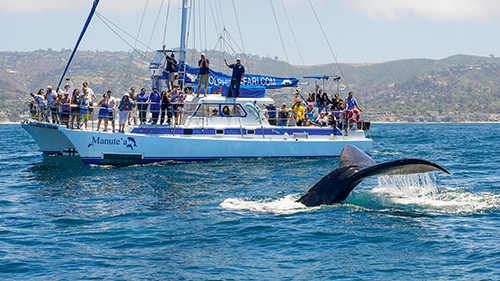
Photo by Mike Johnson/Capt. Dave’s Dolphin & Whale Watching Safari
We don’t have to go far to experience marine life and coastal adventures in Orange County.
This might not be the time of year to take a cooling swim in the ocean waves. But it’s definitely the right season to appreciate living along the coast in ways that are just as fun.
February and the next couple of months are prime whale-watching season as the California gray whales work their way north back to Alaska. There’s a good chance you’ll see a lot more, too.
Whales that were rare sights off Orange County a couple of decades ago have been making a comeback. Humpbacks, which often put on a show for the whale-watching cruises, are now a fairly common sight offshore. Blue whales, the largest animal ever, also make frequent appearances, though they’re more common in the summer months.
On my many whale-watching trips, I’ve also seen fin whales, which can reach speeds of 23 miles an hour; minke whales, often called the “stinky minke” because of the awful odor of its blow; pilot whales; and false killer whales. I’m still hoping to see the rarest of sights, an actual killer whale and maybe, the crown jewel, a sperm whale.
But of course, the most dependable are the gray whales on their annual migration in the fall to give birth in Baja and then their return back up the coast now. If you’re very lucky, you might see one from land, especially this winter and spring. That’s when the mothers and calves hew closer to shore.
One day, walking along Heisler Park in Laguna Beach, I watched as a mom and her offspring came so close in one cove, they looked as though they might beach themselves. But after nosing around for a few minutes, they turned away and headed north again.
The best whale-watching spot for those who prefer to remain land-bound is the Dana Point Headlands, a great (and free) place for a short and easy hike. As you draw close to the water, there are nooks specifically for taking in the ocean sights. If you go when the interpretive center is open, you can borrow a pair of binoculars at no cost.
Of course, most whales will be swimming some distance from shore. The best way to spot them is to look for their blow, the misty spray from the whale’s blowhole. It’s much easier to see those on a sunny day than a gray one.
Out on the cruises, though whales are the big attraction, it can be just as fun and awe-inspiring to find your boat in the midst of a large pod of dolphins as they leap through the air. A recent cruise out of Dana Point caught the rare sight of three gray whales frolicking with dolphins and sea lions.
There are several operators in the county working out of Newport Beach and Dana Point. Before making reservations, search a coupon site, or just do an online search for Orange County whale watching coupons. They generally bring the price down to about $20 per person for a two-hour cruise.
In addition to casting your eyes out to the water for sea life, winter is the perfect time to find marine animals by looking down at your feet at tide pools in Crystal Cove, Laguna Beach or Dana Point. Daytime low tides tend to be much lower in winter, which means you can see a lot more sea life — sea anemones, urchins, crabs, barnacles, occasional sea stars and more.
Check out “tides and times” tables online for the city you plan to visit and pick a date that has the lowest tide you can find at a time that’s convenient for you. It’s also worthwhile to spend some time with your children on the website californiatidepools.com, which includes a terrific illustrated guide to the animals you’re likely to come across and also explains how the tide pools work.
It’s important to remember how gently the tide pools, which are suffering from overloads of visitors, need to be treated. That includes not removing any animals or even any shells from tide pools. Why would an empty mussel shell be important? One example: Look at a closed sea anemone. They cover themselves with bits of crushed shell and rock to protect themselves from the sun and dry air. If all the visitors took a single rock or shell home, the tide pools would be bare.
Avoid walking on sea life while you’re there, picking up the animals or poking the anemones. As a tide pool docent, I’ve found that children are especially eager to be good stewards of these rocky homes for animals.
Want a tamer experience? You can always learn more about tide pools and marine life by visiting one of the local institutions devoted to them. In addition to the biggie, the Aquarium of the Pacific in Long Beach, the Ocean Institute in Dana Point provides science weekends and other educational activities for families. And the Back Bay Science Center in Newport Beach offers hands-on ocean-themed activities for kids during its community open houses on Sundays from 10 a.m. to 2 p.m.
Whether it’s indoors, on the beach or out at sea, winter has its own unique reasons for us to be glad we live at the water’s edge.
By Karin Klein









Leave a Reply